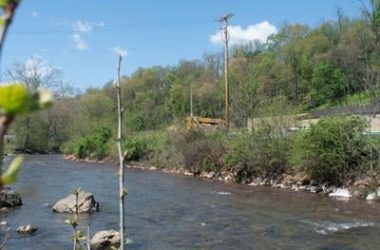By RICK STEELHAMMER
Charleston Gazette-Mail
WEBSTER SPRINGS, W.Va. — A long and winding road that began in Chicago, veered through Vietnam and connected with England brought Mickey and Jenny Janowski to this steep-walled, 100-acre chunk of a Webster County hollow more than a mile from the nearest neighbor where they have made their home — literally — since the 1970s.

(Photo by Kenny Kemp)
“All the logs and stone for the house came from the land,” said Janowski, a wiry, animated, retired union carpenter.
After felling and trimming trees in the vicinity of their homesite, the logs were moved to the construction area with a hand-ratcheted come-along and cable, and after being cut to the appropriate dimensions, were lifted into place with block-and-tackle gear.
The do-it-yourself approach to home-building may have been cost-effective and spiritually rewarding, but it wasn’t fast or easy.
The couple lived in a tent for three years as they worked on their house during the more temperate months, and spent the off-seasons working on construction jobs anywhere from Snowshoe Mountain Resort in neighboring Pocahontas County to New Mexico to raise the funds needed to complete their home-building project.
“We finally got it under roof in 1979,” Janowski said.
Then work began on a series of steadily evolving projects designed to supply their home with power in a way that not only keeps it off the grid, but does so while leaving an extremely light carbon footprint.
Janowski, a Chicago native, was working in construction in his hometown when he was drafted into the Army in 1969 and sent to Vietnam, where he spent a year in the bush as a member of the 11th Light Infantry Brigade.

(Photo by Kenny Kemp)
Back in Chicago after his tour of duty ended, he resumed work as a union carpenter. “But my head was still spun around from Vietnam, so a couple of pals who were dust-off (medical evacuation helicopter) pilots and I decided to start a little revolution of our own and get back to the land and be as self-sufficient as possible.”
One of Janowski’s Vietnam vet pals was from Huntington, “and he was a friend of a friend who lived in Webster County,” he said. Mickey and Jenny — who met each other while Jenny was an English exchange student studying art and working in a Chicago restaurant to raise travel money — made the trip to West Virginia to look for land in the mountainous, central West Virginia county.
“When I came down here and walked onto this land, I just knew this was it,” Janowski said.
“I don’t think I’d ever seen so many trees in my life,” said Jenny Janowski, who lived in large cities in England before moving to Chicago.
“We’re two of the luckiest people in the world to have found West Virginia,” Janowski said. “I guess I can thank ’Nam for that.”
Once their wood stove-heated log home was under roof, the Janowskis supplied it with running water by connecting it via a one-inch-diameter water line to a year-round spring 55 feet higher in elevation than their home to ensure more than adequate pressure. It required digging a 400-foot trench to bury the water line for insulation and aesthetic purposes.
Initially, the Janowskis relied on candles and kerosene lamps to light their home, and they made use of a kerosene refrigerator for food storage. Later, “sometime when Jimmy Carter was president,” according to Janowski, he installed a 35-watt solar photo-voltaic module and used a car battery to store the energy it produced — enough to power a 12-volt car taillight bulb for use as a reading light.
Gradually, he added components to his solar power system and now has 635 watts of PV modules mounted on a platform atop a pole that can be turned to track the sun. The upgraded array feeds six deep-cycle storage batteries and provides enough power to operate lights, a ceiling fan, a stereo, a food blender and several other small appliances.
A propane tank supplied the energy to handle most of the home’s major power loads, including water heating, refrigeration and cooking.
“I had looked at all that power flowing by for years,” he said.
During that time, improvements in design and technology were making small-scale hydroelectric production more efficient and affordable. In 2012, Janowski decided it was time to build a micro-hydro system of his own.
The Webster County man started the process by clearing a straight as possible channel for the penstock — the pipe carrying water from an intake point to a turbine — through the rocks and rhododendron roots lining the creek from a weir site just below his home to the place where his miniature powerhouse would be built. A concrete saw with a diamond-tipped blade was used to cut through rocks to accommodate the 4-inch-diameter, 515-foot long PVC penstock, which drops 47 feet in elevation from intake to outflow.
The penstock was buried to provide insulation and prevent freezing, for aesthetic purposes and to keep bears from messing with it.
“Bears like to chew up anything they don’t understand,” Janowski said. At his place, they have gnawed on plastic fuel cans and chewed a hole through the fence surrounding the raised bed organic garden his wife tends.
Janowski built a concrete weir that blends with a stream-wide flat rock, and channels water into an aluminum intake box he designed and built, which is topped with a debris-shedding screen fabricated by Conn-Weld Industries of Princeton. In the powerhouse at the lower end of the penstock, water enters a Stream Engine turbine built by Energy Systems and Design, using a manifold Janowski designed and built.
The couple’s micro-hydro power plant went online on Oct. 29, 2012, the day Hurricane Sandy hit West Virginia, dumping massive amounts of snow across the state, causing widespread power outages. The Janowskis, however, had power to spare, thanks to their backyard hydro-power operation.
“It works on the same principle as the Hoover Dam, but it can be done small-scale very easily,” Janowski said. “Technology has come a long way with this stuff. There’s all kinds of information out there now, and you can even buy pre-built systems that you can just plug in and start using.”
The Janowskis had certified electrician and solar power expert Matthew Sherald of PIMBY (Power In My Back Yard) Energy of Thomas check out their system before flipping the “on” switch. “I would recommend that anyone who builds a micro-hydro system have a certified electrician take a look at it before operating it,” he said.
Janowski said his system, which he describes as overbuilt, cost about $12,000. “It could be done for half that,” he said.
With the addition of the micro-hydro system — which provides about 90 percent of their electricity, while the solar array accounts for the rest during periods of exceptionally low flow — “we have more power than we can use,” Janowski said, even with the addition of a freezer, washer, dryer and microwave oven. The gas generator the couple once ran about 10 hours a week during winter is no longer needed.
“Once the system’s hooked up, it’s pretty much hands-free and really easy to operate,” Janowski said. “Water power is such a great natural resource here in the West Virginia mountains, where there are hundreds of creeks like this. It’s a resource that’s been overlooked, but it can be done on this scale very easily.”
Janowski has spoken about his system and the potential for more micro-hydro installations in the Mountain State to school groups, the West Virginia Small Farms Conference and individuals interested in building systems of their own.
“Micro-hydro has become very popular in California and Oregon, and there’s no reason why it can’t catch on here,” he said. “But it’s a change that needs to come from the bottom up.”
For detailed information on the Janowskis’ micro-hydro power system, including photos of the system being built a video on how it operates, and a link to an article on the system in Home Power magazine, visit wvhydro.org.
See more from the Charleston Gazette-Mail






